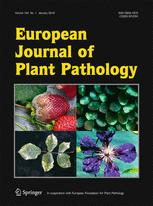Ver ítem
- xmlui.general.dspace_homeCentros e Institutos de InvestigaciónCIAP. Centro de Investigaciones AgropecuariasInstituto de Patología VegetalArtículos científicosxmlui.ArtifactBrowser.ItemViewer.trail
- Inicio
- Centros e Institutos de Investigación
- CIAP. Centro de Investigaciones Agropecuarias
- Instituto de Patología Vegetal
- Artículos científicos
- Ver ítem
Molecular variability of watermelon mosaic virus isolates from Argentina
Resumen
Watermelon mosaic virus (WMV) is an economically important virus of cucurbit crops in Argentina. The available information on genetic variability must be continuously updated. In this study, we assessed the molecular variability of WMV isolates in Argentina based on the partial sequences of the NIb-CP region and compared them with isolates previously reported from around the world. Forty-six WMV isolates were obtained from naturally infected cucurbit
[ver mas...]
Watermelon mosaic virus (WMV) is an economically important virus of cucurbit crops in Argentina. The available information on genetic variability must be continuously updated. In this study, we assessed the molecular variability of WMV isolates in Argentina based on the partial sequences of the NIb-CP region and compared them with isolates previously reported from around the world. Forty-six WMV isolates were obtained from naturally infected cucurbit crops collected from 10 provinces between 2011 and 2018. At the molecular level, WMV isolates were grouped into three distinct major phylogenetic groups based on genetic distance. Majority of the Argentine isolates belonged to the emerging group (G3), whereas one isolate was included in G1 and another cluster in G2. G3 was further divided into 5 subgroups, named EM1, EM2, EM3, EM4, and a new group “EMArg”, composed exclusively of Argentine isolates with high bootstrap support and high level of significance. Tajima’s D and Fu were significantly negative for G3 and EMArg, indicating that the population of this subgroup has recently expanded. AMOVA analysis showed that the isolates was not well correlated with their geographic origin. The fixation index (FST) value between the WMV isolates from the different provinces in Argentina was lower than 0.33, indicating a relatively frequent gene flow between provinces. In every group, the predominant evolutionary pressure was negative with a mean dN/dS < 1, suggesting a slow replacement fixation rate. One recombination event was detected involving isolates of EM2 cluster from Argentina.
[Cerrar]

Autor
Pozzi, Elizabeth Alicia;
Perotto, Maria Cecilia;
Bertin, S.;
Manglli, A.;
Luciani, Cecilia Elizabeth;
Conci, Vilma Cecilia;
Tomassoli, L.;
Fuente
European Journal of Plant Pathology (2020)
Fecha
2020-03
Editorial
Springer
ISSN
0929-1873
1573-8469
1573-8469
Formato
pdf
Tipo de documento
artículo
Palabras Claves
Derechos de acceso
Restringido
 Excepto donde se diga explicitamente, este item se publica bajo la siguiente descripción: Creative Commons Attribution-NonCommercial-ShareAlike 2.5 Unported (CC BY-NC-SA 2.5)
Excepto donde se diga explicitamente, este item se publica bajo la siguiente descripción: Creative Commons Attribution-NonCommercial-ShareAlike 2.5 Unported (CC BY-NC-SA 2.5)

